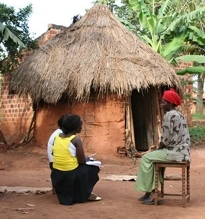Click here to register!
Interviews / Discussions - Qualitative Methods
Overview
Qualitative methods commonly focus in detail on only a few cases, but provide in depth explanatory information (read more Qualitative Methods). Examples for useful qualitative methods are focused qualitative interviews as well as focus group discussions. Furthermore examples will be given for observations.
Qualitative Interviews
Qualitative interviews are well suited to reveal background information and detailed opinions regarding specific thematic aspects. This type of interview is generally conducted within a small number of sampling units. In many cases, information gathered from qualitative interviews may be used as basis for the design of a detailed structured questionnaire for subsequent quantitative surveys. For example, qualitative interviews in a small number of households can reveal information on the energy sources most commonly in use. This data can afterwards be used as answer alternatives for a structured questionnaire. Furthermore, data gathered from quantitative surveys can often be better understood through the acquisition of background information (e.g. regarding underlying cultural patterns) through focused qualitative interviews.
Instead of using large random samples, sampling units for qualitative interviews are often selected by purpose. For example, it might be interesting for a project to gain information on the opinion of a woman from one low-income as well as one high-income household respectively. Other possibilities include interviews with selected businesses with/without electricity, with experts from partner organisations, school teachers or clinic staff.
It is advisable to make use of semi-structured questionnaires containing several open routing questions, as this will assure comparability between the data gathered from different interview partners. Through the use of open questions, respondents are free to articulate their personal view. However, the interviewer has to pay attention to keep the respondent in line with the routing questions.
The requirements for interviewers are generally higher than in the case of quantitative surveys. Interviewers should be eloquent and familiar with the interview topic, so they can flexibly react on the different issues brought up by the interview partners. To record the information, the interviews should be taped and transliterated. Where this is not possible for technical or cultural reasons, interviewers should be urged to take detailed notes on the most important issues.
Focus Group Discussion
Focus Group Discussions are one type of qualitative method, allowing interviewers to study people in a more natural setting than in a one-to-one interview. Focus Group Discussions are low in cost, one can get results relatively quickly, and they provide several opinions by talking to several people at once. However, compared to a one-to-one interview the moderator has less control over the group. Discussions typically take about one to two hours with a group size of usually six to ten members. The discussion should be loosely structured, and the moderator should encourage the free flow of ideas and opinions. Moderators should be highly trained and experienced with the topic of discussion.
Potential members of focus group discussions include members of households, entrepreneurs, representatives of social institutions, etc. To focus on gender aspects, discussions within groups of women/men might also be thinkable.
Discussions can be recorded on video or audio tape. Otherwise, detailed written documentation of the discussion has to be provided.
Observations
Observation of the target groups, villages and project interventions through local field staff is a cheap and simple way of gaining a first impression. Even though not as accurate and representative as structured surveys, observations can be especially useful for preparing further scientific research (e.g. questionnaires) by providing first ‘site-specific’ knowledge.
Observation can also be part of surveys e.g. cooking practice or stove quality, to validate survey questions or to gather further information. As observations are particularly prone to interference by the subjective impression and attitude of the observer, their results, however, should be interpreted with reservations. Enumerators need to be well trained to minimize those negative effects and enable a comparison.
Further Information




















